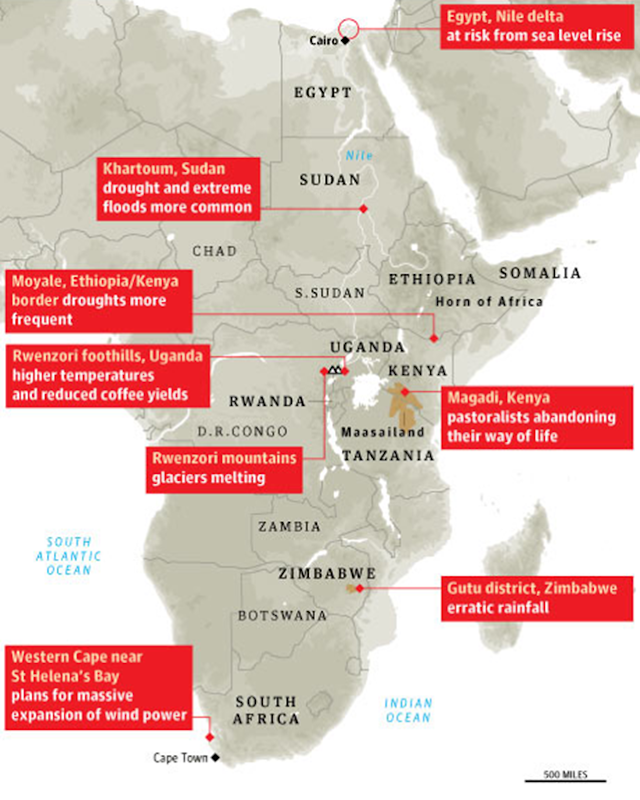From Cairo to the Cape, climate change takes hold of Africa – ‘A new and harsh reality’
By John Vidal, environment editor, www.guardian.co.uk
1 December 2011 We are right on the equator, and Speke, Moebius, Elena, Savoia, and Moore, the five great glaciers of the the Rwenzori, the Mountains of the Moon, glint in the bright Ugandan sun. Usually lost in the mists that cloak these peaks up to 5,100 metres high, the glaciers are the only major ones left of the 43 that were mapped and named in 1906. Then, the ice covered 7.5 square kilometres, now it is thought to cover less than one. Surveys suggest most of the glaciers shrank by nearly half between 1987 and 2003. They will be measured again in January, but air temperatures in all the high tropics have risen several degrees in a few generations and, says the British hydrologist Richard Taylor of University College London, it’s likely that the equatorial ice known to the ancient Greeks will almost certainly have disappeared in 20-30 years. The Rwenzori glaciers cannot be saved by the 194 countries meeting in the UN climate talks in Durban, South Africa, which will move up a gear this weekend as ministers and some heads of state arrive for the serious negotiations. But if the rise in greenhouse gas emissions is not stopped and then rapidly reduced within a few years then Africa, the most vulnerable and poorest continent, will almost certainly experience 4-5C temperature rises within a century, according to the consensus of world climate scientists. Comparatively little research has been done into the possible impacts of climate change in Africa and there are deep uncertainties about timing and severity in individual countries, but the scientific consensus – from the Intergovernmental Panel on Climate Change – is that a rise in temperatures of just 2C would guarantee more intense droughts, heatwaves, floods, stronger storms, sea level rises, crop losses and unliveable cities, and a rise of 4-5C would be calamitous across much of the continent. From Cairo to the Cape, the impact of man-made climate change is already being felt. Farmers, people in cities, local scientists and governments all tell a remarkably similar story – that there is evidence of more extreme and unseasonal weather taking place outside the natural variability and cycles of African climate, and that the poorest communities are the least able to adapt. In Egypt’s Nile delta, where 40% of the population lives, most of the land is liable to be inundated by a one-metre increase in sea levels, anticipated over the next century. Guy Jobbins, a Cairo-based British water scientist who heads Canada’s International Development Research Centre climate change adaptation programme for Africa, says understanding of the issue has rocketed in the past few years. “Go to any farm, talk to any fisherman, and climate change fits their experience. The last few years have seen temperature spikes to world-record highs. We don’t absolutely know it’s climate change but we do know that the summers are hotter now, and the impact of evaporation is greater in the south of Egypt. We see crops dying in the fields, temperatures of 63C [145F] have been recorded, and the winters are not cold enough to grow olives. There are some advantages, like the fact that vegetables grow earlier, but smallholders have no way of taking advantage. “We know sea level rise is happening but it’s slow and steady. But the effect is being aggravated by the increasing intensity of storms. Last year saw the worst [storms] in decades. The last few years have seen temperature spikes, with nights becoming unbearably hot and then switching to freezing cold. But the real issues are groundwater and soil salination. Coastal aquifers become depleted, which leads to groundwater becoming salinated. As sea levels rise the water becomes more stagnant and salty. It’s affecting hundreds of square kilometres, up to 10km from the coast in places. … Climate change is a massive problem for developing countries because people are less resistant to shocks and cannot adapt.” A thousand miles south in Khartoum, Sumaya Zakieldeen, a researcher at Khartoum University’s institute of environmental studies, says the harsh climate that Sudan already experiences will become more extreme. She and her team have compared historical data going back to 1940 and found drought and extreme flooding more frequent, temperatures rising in winter, extreme – good and bad – years now more common and rainfall patterns changing. A major UN study from 2007 – From Conflict to Peacebuilding: The Role of Natural Resources and the Environment – says temperatures are set to rise by several degrees in the next 50 years, with rainfall declining 5%. Climate change, say the authors, presents a “new and harsh reality”. […]
From Cairo to the Cape, climate change begins to take hold of Africa
